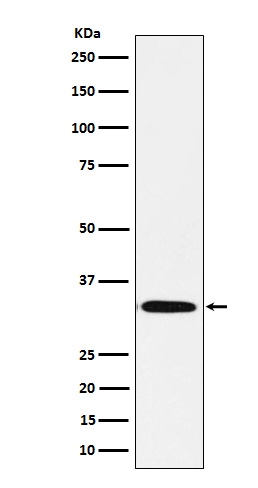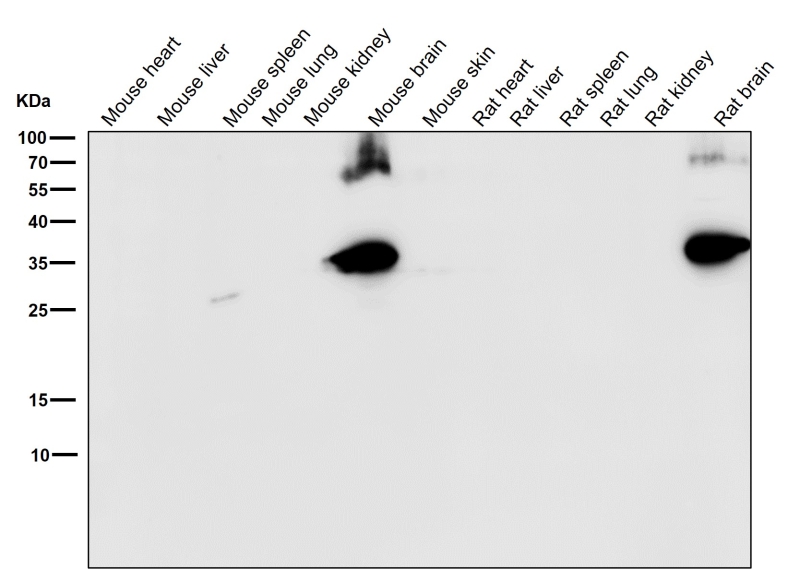

| WB | 咨询技术 | Human,Mouse,Rat |
| IF | 1/20-1/50 | Human,Mouse,Rat |
| IHC | 咨询技术 | Human,Mouse,Rat |
| ICC | 技术咨询 | Human,Mouse,Rat |
| FCM | 咨询技术 | Human,Mouse,Rat |
| Elisa | 咨询技术 | Human,Mouse,Rat |
| Aliases | EPIM; Epimorphin; EPM; HPC 1; P35 1; STX1A; Stx1b; STX1B1; STX1B2; STX2; STX2A; STX2B; STX2C; STX3; STX3A;;Syntaxin 1B |
| WB Predicted band size | 33 kDa |
| Host/Isotype | Rabbit IgG |
| Antibody Type | Primary antibody |
| Storage | Store at 4°C short term. Aliquot and store at -20°C long term. Avoid freeze/thaw cycles. |
| Species Reactivity | Human,Mouse,Rat |
| Immunogen | A synthesized peptide derived from human Syntaxin 1B |
| Formulation | Purified antibody in PBS with 0.05% sodium azide,0.05% BSA and 50% glycerol. |
+ +
以下是3篇涉及Syntaxin抗体的参考文献及其摘要内容:
---
1. **文献名称**:*Identification of a transmembrane glycoprotein specific for secretory vesicles of neural and endocrine cells*
**作者**:Bennett, M. K., Calakos, N., & Scheller, R. H.
**摘要**:该研究利用Syntaxin抗体(如抗Syntaxin-1A)通过免疫印迹和免疫组化技术,揭示了Syntaxin蛋白在神经元和内分泌细胞分泌囊泡中的特异性表达,并证明其参与突触囊泡与质膜的融合过程。
---
2. **文献名称**:*The SNARE protein SNAP-25 is required for synaptic vesicle exocytosis*
**作者**:Söllner, T., Whiteheart, S. W., Brunner, M., et al.
**摘要**:研究通过Syntaxin抗体与SNAP-25抗体的共定位实验,证实Syntaxin-1与SNAP-25形成SNARE复合体,在突触囊泡胞吐作用中起核心作用,抗体阻断实验进一步验证了其功能必要性。
---
3. **文献名称**:*Subcellular localization of syntaxin isoforms in insulin-secreting cells*
**作者**:Nagamatsu, S., Fujiwara, T., Nakamichi, Y., et al.
**摘要**:利用Syntaxin-3和Syntaxin-4特异性抗体进行免疫荧光染色,发现这两种亚型在胰岛β细胞中分别定位于质膜和高尔基体,提示其在胰岛素分泌囊泡运输中的差异性调控作用。
---
以上文献均通过特定Syntaxin抗体的实验手段(如免疫印迹、免疫组化、功能抑制等),阐明了Syntaxin蛋白在不同细胞分泌机制中的表达定位及功能。
Syntaxin antibodies are essential tools in neuroscience and cell biology research, targeting proteins belonging to the syntaxin family—a subset of SNARE (soluble N-ethylmaleimide-sensitive factor attachment protein receptor) proteins critical for membrane fusion events. Syntaxins are transmembrane proteins localized to specific cellular compartments, such as the plasma membrane, synaptic vesicles, or Golgi apparatus, where they mediate vesicle docking and fusion with target membranes. Among the 15+ mammalian isoforms, syntaxin-1A/B is particularly well-studied for its role in neurotransmitter release at neuronal synapses, interacting with partner SNAREs (e.g., SNAP-25 and synaptobrevin) to form the core complex that drives exocytosis.
Syntaxin antibodies are widely used to investigate synaptic function, intracellular trafficking, and membrane dynamics. They enable techniques like Western blotting, immunohistochemistry, and immunofluorescence to visualize syntaxin expression, localization, and interactions. For example, syntaxin-1 antibodies help map synaptic terminals or study defects in neurotransmitter release models. Other isoforms, like syntaxin-4 (involved in insulin secretion) or syntaxin-17 (autophagy-related), are targeted to explore non-neuronal processes. Dysregulation of syntaxins has been linked to neurological disorders (e.g., epilepsy, Alzheimer’s), endocrine diseases, and cancer, making these antibodies valuable for both basic research and clinical diagnostics. Their specificity and validation (e.g., knockout controls) are critical to ensure accurate interpretation of cellular mechanisms.
×